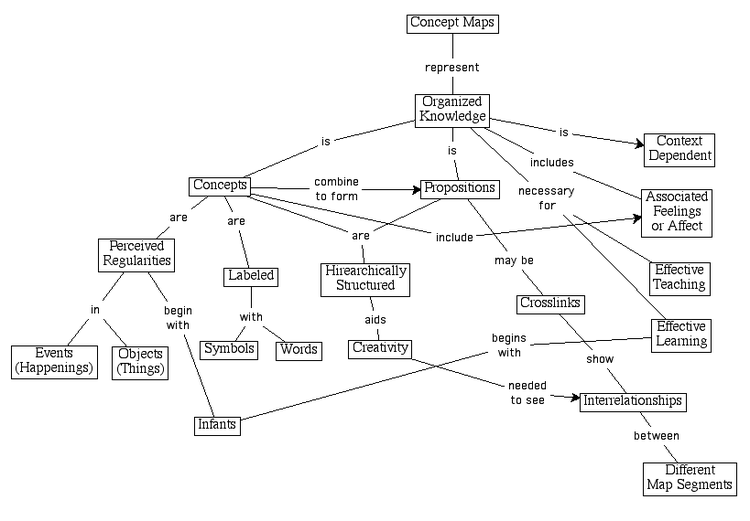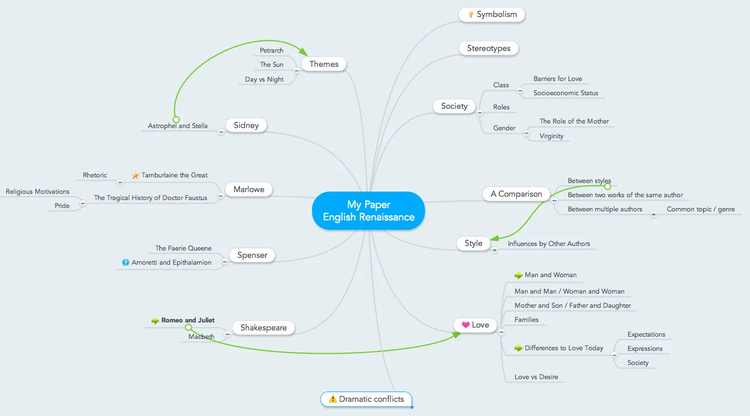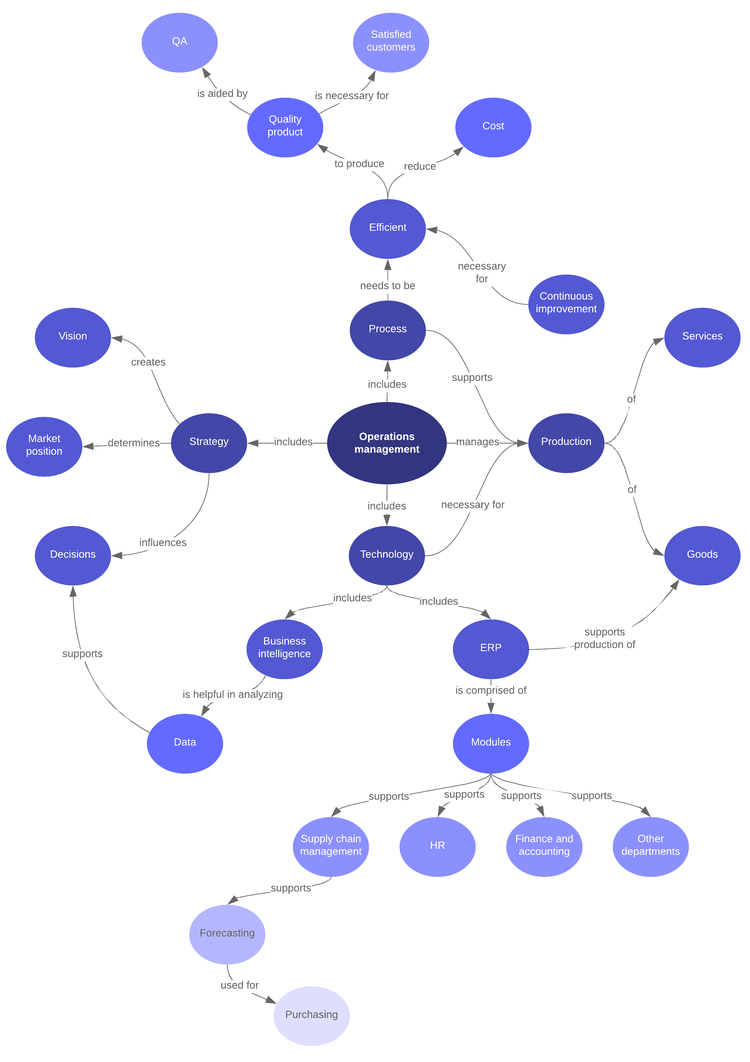Ideas can sometimes be difficult to visualize -- even more so when you try to envision the relationships between several concepts. One diagramming tool that’s widely used to illustrate connections between new and known information is the concept map.
Overview: What is a concept map?
A concept map, or conceptual diagram, is a graphical mapping tool that organizes ideas and visually represents the relationships between concepts. Because the human brain processes visuals better than plain text, concept mapping facilitates an individual’s ability to understand and remember information.

Here’s a concept map explaining what concept maps are. Notice the different elements: rectangles, lines, arrows, and descriptive text. Source: msu.edu.
Developed in 1972 by research scientist and American educator Joseph D. Novak and his team at Cornell University, the concept map was originally used to represent students’ understanding of basic science concepts.
Today, conceptual mapping is popular not just in research and education but also in other fields, such as government and business.
In product development, for example, engineers, designers, and product owners may use a concept map to show and highlight the relationships between ideas during the different development or project cycle management stages. This enables them to create a work plan that covers all the bases, including the best ways to handle risks.
In small business project management, a concept map can be a useful tool for project planning as well, as it presents the big picture in a way that’s easy for everyone to grasp. As projects become complicated, mapping out the processes involved throughout the different project phases clarifies the tasks required for completion.
Concept map vs. mind map: What's the difference?
Concept maps and mind maps are often used interchangeably, but consider key differences between the two.
- Structure: Concept maps usually follow a hierarchical top-to-bottom format, while mind maps are radial in structure, starting at the center and spreading outward in all directions.
- Focus: Concept maps involve many connected ideas or concepts, while mind maps focus on a single word or idea. Concept map connections are diverse, while mind map ideas connect to a central concept.
- Labels: Concept maps use linking words to illustrate relationships between concepts. Mind maps have few, if any.
- Purpose: Concept maps or conceptual charts are best used for consolidating knowledge and analyzing problems, while mind maps are mostly used for brainstorming and creative thinking. Concept maps require more detailed thinking, while mind maps can be done spontaneously.

Here’s an example of a mind map. As you can see, the relationships between ideas aren’t immediately clear, and the mind map represents the author’s thought processes during creation. Image source: Author
When should you use a concept map?
Concept maps are powerful visual tools that can be used in many scenarios:
- To facilitate learning: Illustrate connections between tacit and newly acquired knowledge to promote critical and creative thinking among learners.
- To evaluate knowledge and understanding of processes: Assess your team’s understanding of the project roadmap and the associated project management steps.
- To develop new business concepts and strategies: Use concept maps to share business ideas and create strategic action plans.
- To communicate research findings: Present your findings effectively by summarizing volumes of text and still retaining the meaning.
5 key characteristics of concept maps
Concept maps have specific characteristics -- or elements -- that differentiate them from other mapping tools.
1. Nodes
Nodes represent a concept. Circles and rectangles are the most commonly used shapes for nodes. They may vary in size, depending on their position or hierarchy on the concept map.
Nodes representing general concepts are usually at the top of the map, or close to the central idea, if the structure used is not hierarchical. They may be bigger than the more specific nodes following them. I’ll look more closely at structure below.
2. Cross-links
Cross-links are the lines or arrows that link one node to another. They illustrate the relationships between two concepts.
3. Linking words or phrases
These are the words or short phrases describing the relationships between two linked concepts or nodes. They appear as cross-link labels on a concept map outline.
4. Hierarchical structure
A major characteristic of the concept map method is its structure, which is hierarchical. At the top of the map are the most inclusive and general concepts, while the more exclusive and specific are placed below them. This is why concept maps are typically read from top to bottom.
Some concept maps use other structural approaches, such as from the center and then spreading out, like in a spider concept map.

Here’s an example of a spider concept map, in which the main topic, operations management, is positioned at the center of the map. Image source: Author
5. Focus question
A focus question defines the problem to be solved and provides the map’s direction. It’s also used to narrow down broad topics.
6. Proposition
When two or more concepts are connected using linking words, they form a meaningful statement called a proposition.
How to create your own concept map
Now that we know the key elements and characteristics of a concept map, we’re ready to create one.
1. Choose your drawing tool
To create a concept map, you’ll need a drawing tool. Depending on what you have available, you may use pen and paper, a whiteboard, or a diagramming tool such as Creately or Lucidchart.
One key advantage of a cloud-based concept mapping platform over traditional tools is that you can save your work, edit, and share it with colleagues using collaboration or project management software. This is especially beneficial if you intend to use the concept map as a visual aid for developing a project management plan or as a reference document for the project team.
2. Identify your main topic
Choose your main topic or central idea. It can be anything from a research topic to a business problem you’re trying to solve. The key thing to note here is that you can only choose one main topic. Topics can be too broad, and your concept map can get too big and prove unhelpful.
For instance, the topic “online shopping” is likely to branch out in several directions because there are many related concepts to explore, including the history of online shopping, statistics related to online shopping, online shopping and the coronavirus pandemic, staying safe when shopping online, starting an online shopping business, and so on. You want your main topic to be more specific, so narrow it down with a focus question.
3. Create a list of related topics
Next, come up with a list -- also called a parking lot -- of related ideas, which can be components of the main topic or the process steps required to carry it out. Refer to the main topic and your focus question for guidance. List 15 to 25 key concepts you can sort through later.
Going back to our online shopping example, if your main topic is about setting up an e-commerce business, your list of related concepts may include product research, dropshipping, Amazon FBA, mobile commerce, payments, e-commerce platforms, sourcing, procurement, inventory management, website management, marketing, sales, fulfillment, and customer service.
When writing out your key concepts, be brief. Limit each to one or two words. You can always add details later.
4. Add concepts to your map
Once your list of related ideas is ready, you can place them on your map. Although you’re free to use other structural formats, your best bet for organizing a concept map is still the hierarchical structure. Meaning, your main topic will be right there on top of the map, with the most general and broadest of concepts below it. As you move further down, the ideas become more and more specific.
5. Connect related concepts
Link related ideas with arrows, and add text to illustrate how they’re connected. For our e-commerce business example, you may connect an arrow from the main topic, “e-commerce business,” to “product research.” When you label the arrow with the linking word “includes,” you form the statement, “E-commerce business includes product research.”
This simple sentence describing the link between the two concepts is a proposition. When completed, your concept map will have several propositions.
6. Refine your concept map
Once done with your preliminary concept map, check for areas that need fine-tuning. Are your linking words accurate? Are the concepts properly positioned? You may also add comments or notes, rearrange the nodes, and even apply color and styling.
Organizing knowledge with concept maps
Concept maps represent knowledge. They illustrate the relationships between ideas, reinforce previous knowledge by linking new information or ideas back to it, and can be used for many purposes. If you need help creating your own concept map, follow the steps we’ve laid out above.
Our Small Business Expert
We're firm believers in the Golden Rule, which is why editorial opinions are ours alone and have not been previously reviewed, approved, or endorsed by included advertisers. The Ascent does not cover all offers on the market. Editorial content from The Ascent is separate from The Motley Fool editorial content and is created by a different analyst team.